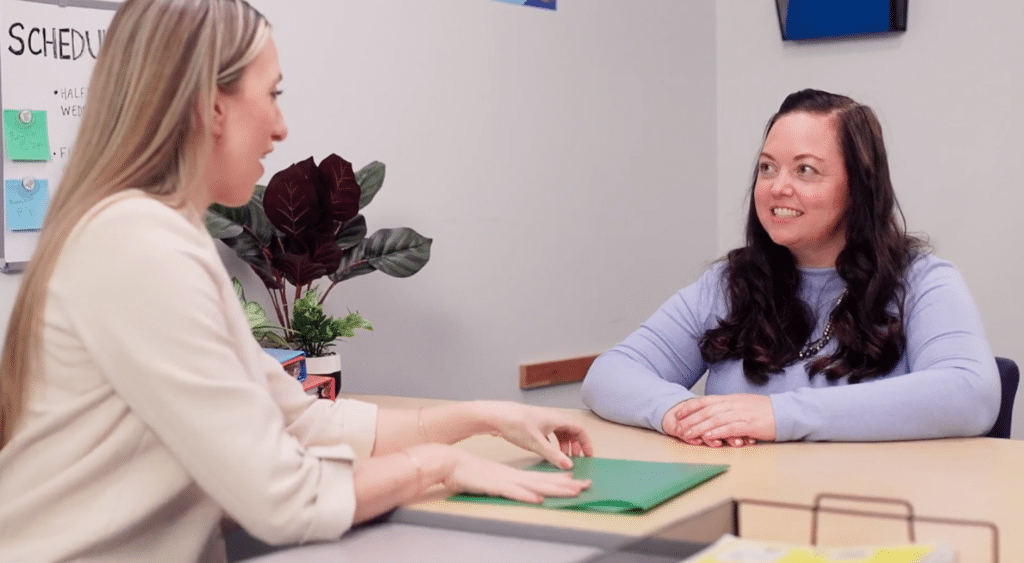What’s the difference between a substitute teacher and a teacher assistant?

If you’re interested in making a difference in the lives of students, this is a fantastic time to become a substitute teacher or teaching assistant, also known as a teacher’s aide. These roles are in high demand at school districts across the country.
In fact, The National Center for Education Statistics reports that 41% of public schools in the United States are looking to fill classroom aide positions ahead of the 2024–25 school year. If you’ve always wanted to work in a school, but aren’t qualified to work as a full-time teacher, you’ll find invaluable experience by becoming a substitute teacher or teaching assistant.
Let’s look at what’s the difference between a substitute teacher and a teacher assistant.
Teacher’s aide duties and qualifications.
Teaching assistants support the lead teacher in the classroom. Although a teaching assistant doesn’t take a lead role in the classroom, they focus on providing additional support to students who need it, freeing up the teacher to spend time on instruction and other tasks. Teaching assistants may:
- Facilitate small and large group instruction
- Provide tutoring and intervention wherever needed
- Assist students with special needs (may also be a paraeducator or paraprofessional role)
- Set up and clean-up of activities
- Ensure students aren’t left alone in classroom
To see more, check out this example of a typical substitute aide job description for an early childhood position.
Substitute teacher duties and qualifications.
An effective substitute teacher provides a quality replacement for a full-time teacher and ensures that the teacher’s absence doesn’t stop student learning. Substitute teachers work under the district’s direction and supervision by executing lesson plans left behind by the teacher.
Just as no two schools or classrooms are exactly alike, a substitute teacher’s role may vary. Here’s an example of a typical substitute teacher job description. Substitute teacher duties may include:
- Provide instruction for scheduled lessons
- Create a classroom environment conducive to learning and appropriate to the students’ maturity and interests.
- Supervise students inside and outside of the classroom
- Inform administrators or neighboring teachers of disruptive behavior
- Assign homework
Read this article for a more comprehensive look at other possible duties. Remember that long-term substitute teachers will have additional responsibilities including lesson planning and grading.
Hours and flexibility.
Both roles operate during normal school hours. So, holidays, evenings, weekends, and summer breaks are all yours to spend how you choose. However, school districts often offer additional flexible summer school opportunities for those who want to work more.
Both roles enjoy a great deal of flexibility. Some jobs will be long-term commitments, for instance, when filling in for parental or medical leave. Other assignments will be last-minute requests, but substitute teachers and aides are generally able to accept or decline depending on availability. Hours and locations may vary but that provides freedom to decide when and where you want to work.
Qualifications.
To work in a general education setting, teaching assistants normally don’t need more than an associate degree, and in some cases, a high school diploma is sufficient. Teaching assistants working in a more specialized capacity, such as in early childhood or special education classrooms or settings that require extra care for student needs may need additional degrees, licenses, and certifications. Schools that receive Title I funding and other federal support for low-income students also have more requirements.
In some states, a higher education degree or at least 60 credit hours of coursework at an accredited institution is a requirement for substitute teachers. In other states, there’s a minimum requirement of a high school diploma or equivalent. Ongoing staffing shortages have prompted many states to loosen requirements. Check out this article to learn about the minimum requirements to become a substitute teacher in your state.
How to become a substitute teacher or teaching assistant.
Looking for flexible work that makes a difference for students? Wondering where are the substitute teacher jobs near me? Fill out our brief interest form and one of our recruiters will contact you to answer your questions and share more about opportunities to become a sub teacher with one of our school district partners.
View Related: Article Job searching
You might like
Do substitute teachers get health benefits?
3 minute read
What a substitute teacher does.
4 minute read
Do substitute teachers get health benefits?
3 minute read
What a substitute teacher does.
4 minute read
Find your next job
Discover thousands of temporary, full-time, and remote jobs for beginning and experienced job seekers.



